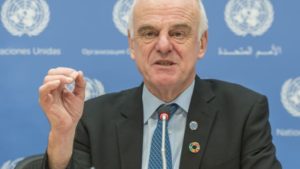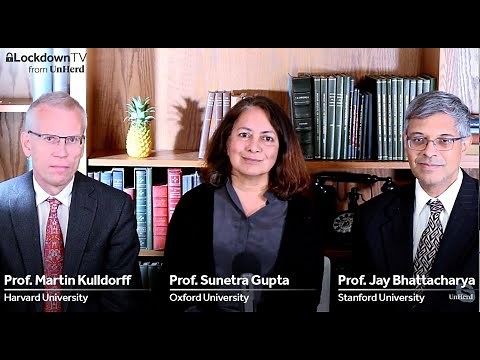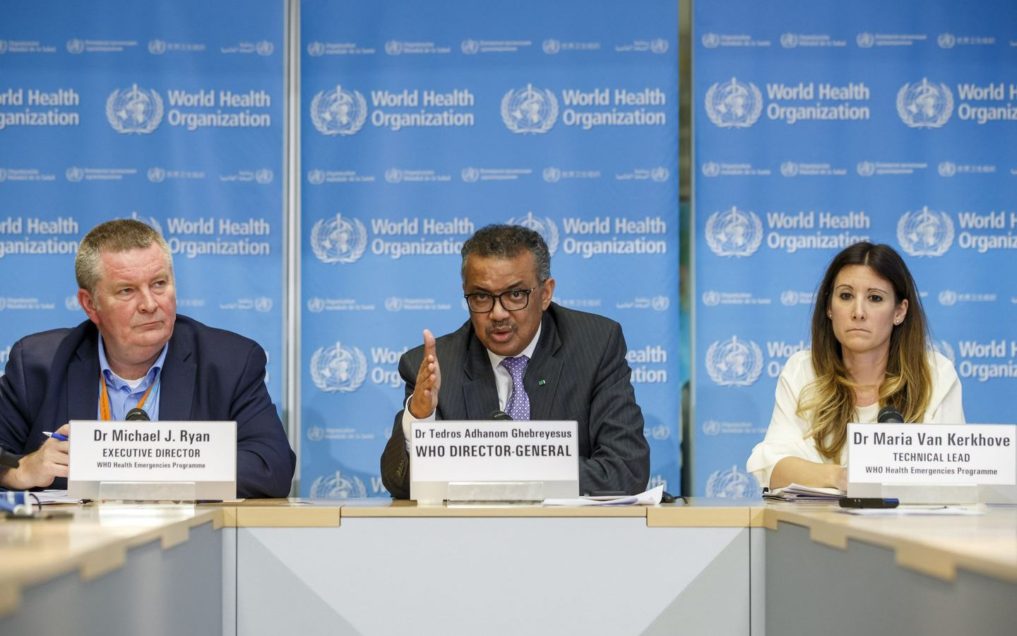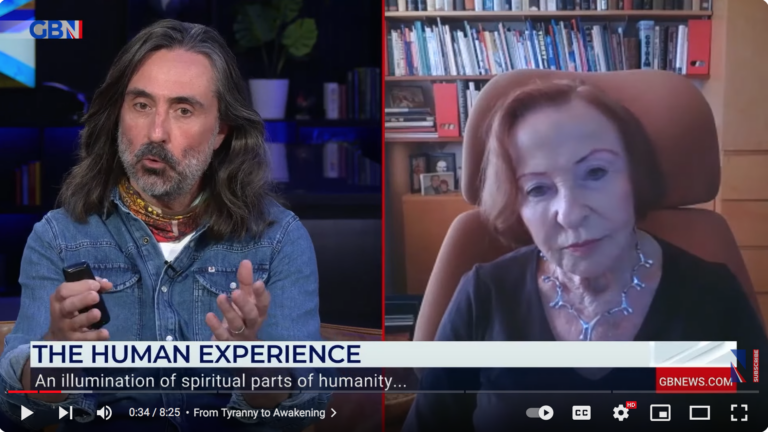The WHO Revised Covid-19 Infection/ Fatality Rate & the Great Barrington Declaration – Updated
UPDATE 10/11/2020:
The Great Barrington Declaration garnered more than 100,000 signatories by Oct. 8th, when Rddit and r/COVID-19 channel “moderators’ censored and removed the Declaration from their sites.
- Censorship of scientists reveals that genuine science and scientific discourse pose a major threat to those who exploit the COVID-19 Pandemic for political and financial self-interest.
On October 10th, Dr. David Nabarro,the UK special envoy to the World Health Organization joined in condemning mass coronavirus lockdowns as a “ghastly global catastrophe”. Video

WHO Backflips On Virus Stance By Condemning Lockdowns
“Lockdowns have been used to control the coronavirus around the world, plunging millions of lives into chaos. Now the WHO has changed its mind
Dr. Nabarro appealed to world leaders yesterday, telling them to stop “using lockdowns as your primary control method” of the coronavirus.
He also claimed that the only thing lockdowns achieved was poverty – with no mention of the potential lives saved.
“Lockdowns just have one consequence that you must never ever belittle, and that is making poor people an awful lot poorer,” he said.
On October 5, 2020, two milestones occurred that should restore sanity to the Covid-19 response.
- The American Institute for Economic Research announced The Great Barrington Declaration, authored by:
- Dr. Martin Kulldorff, Professor, Medicine, Harvard Medical School.
- Dr. Jay Bhattacharya, Professor, Medicine, Stanford University.
- Dr. Sunetra Gupta, Professor, Theoretical Epidemiology, University of Oxford.

The co- signatories are eminent infectious disease epidemiologists and public health scientists, all of who have grave concerns about the damaging physical and mental health impacts of the prevailing COVID-19 policies.
The Great Barrington Declaration calls for a “Focused Protection” strategy, and an end to lockdowns. Read the Great Barrington Declaration below and add your voice as a signatory.
2. During a special session of the World Health Organization’s 34-member executive board.
Dr Michael Ryan, the WHO’s Head of Emergencies revealed that the WHO’s “current best estimates tell us that [perfectpullquote align=”left” bordertop=”false” cite=”” link=”” color=”” class=”” size=””]“about 10% of the global population has been infected by the virus.”[/perfectpullquote]
This is a huge increase over the number of officially recognized cases (around 35 million). Dr. Margaret Harris, a WHO spokeswoman, later confirmed the figure, stating it was based on the average results of all the broad seroprevalence studies done around the world. As Off-Guardian reported,
“The global population is roughly 7.8 billion people, if 10% have been infected that is 780 million cases. The global death toll currently attributed to Sars-Cov-2 infections is 1,061,539. [perfectpullquote align=”right” bordertop=”false” cite=”” link=”” color=”” class=”” size=””]That’s an infection fatality rate of roughly 0.14%. [/perfectpullquote]
Right in line with seasonal flu and the predictions of many experts from all around the world.
0.14% is over 24 times LOWER than the WHO’s “provisional figure” of 3.4% back in March. This figure was used in the models which were used to justify lockdowns and other draconian policies.
In fact, given the over-reporting of alleged Covid deaths, the [infection fatality rate[ IFR is likely even lower than 0.14%, and could show Covid to be much less dangerous than flu.
None of the mainstream press picked up on this. Though many outlets reported Dr Ryan’s words, they all attempted to make it a scary headline and spread more panic.”
- Why is the mainstream media determined to maintain a heightened level of fear???
Focused Protection Strategy; The Great Barrington Declaration
AMERICAN INSTITUTE OF ECONOMIC RESEARCH
– October 5, 2020From October 1-4, 2020, the American Institute for Economic Research hosted a remarkable to discuss the global emergency created by the unprecedented use of state compulsion in the management of the Covid-19 pandemic. The result is which urges a “Focused Protection” strategy.
As infectious disease epidemiologists and public health scientists we have grave concerns about the damaging physical and mental health impacts of the prevailing COVID-19 policies, and recommend an approach we call Focused Protection.
After a brief explanation of the strategy, and a discussion of the astonishing costs of lockdown, the Declaration concludes: “Schools and universities should be open for in-person teaching. Extracurricular activities, such as sports, should be resumed. Young low-risk adults should work normally, rather than from home. Restaurants and other businesses should open. Arts, music, sport and other cultural activities should resume.”
The primary authors and signers of the document are
- Dr. Martin Kulldorff, Professor, Medicine, Harvard Medical School.
- Dr. Jay Bhattacharya, Professor, Medicine, Stanford University.
- Dr. Sunetra Gupta, Professor, Theoretical Epidemiology, University of Oxford.
The American Institute for Economic Research was founded in 1933 in the midst of an economic crisis in the United States. Its purpose was and is to research and promulgate evidence-based solutions to social and economic problems, with a particular focus on the importance of functioning markets. The crisis of the policy response to Covid-19 drew AIER’s close attention from late January 2020 and following. The hosting of this crucial meeting was in the interest of backing the best science, promoting essential human rights, and reviving a focus on the common good.
The Great Barrington Declaration
As infectious disease epidemiologists and public health scientists we have grave concerns about the damaging physical and mental health impacts of the prevailing COVID-19 policies, and recommend an approach we call Focused Protection.
Coming from both the left and right, and around the world, we have devoted our careers to protecting people. Current lockdown policies are producing devastating effects on short and long-term public health. The results (to name a few) include lower childhood vaccination rates, worsening cardiovascular disease outcomes, fewer cancer screenings and deteriorating mental health – leading to greater excess mortality in years to come, with the working class and younger members of society carrying the heaviest burden. Keeping students out of school is a grave injustice.
Keeping these measures in place until a vaccine is available will cause irreparable damage, with the underprivileged disproportionately harmed.
Fortunately, our understanding of the virus is growing. We know that vulnerability to death from COVID-19 is more than a thousand-fold higher in the old and infirm than the young. Indeed, for children, COVID-19 is less dangerous than many other harms, including influenza.
As immunity builds in the population, the risk of infection to all – including the vulnerable – falls. We know that all populations will eventually reach herd immunity – i.e. the point at which the rate of new infections is stable – and that this can be assisted by (but is not dependent upon) a vaccine. Our goal should therefore be to minimize mortality and social harm until we reach herd immunity.
The most compassionate approach that balances the risks and benefits of reaching herd immunity, is to allow those who are at minimal risk of death to live their lives normally to build up immunity to the virus through natural infection, while better protecting those who are at highest risk. We call this Focused Protection.
Adopting measures to protect the vulnerable should be the central aim of public health responses to COVID-19. By way of example, nursing homes should use staff with acquired immunity and perform frequent PCR testing of other staff and all visitors. Staff rotation should be minimized. Retired people living at home should have groceries and other essentials delivered to their home. When possible, they should meet family members outside rather than inside. A comprehensive and detailed list of measures, including approaches to multi-generational households, can be implemented, and is well within the scope and capability of public health professionals.
Those who are not vulnerable should immediately be allowed to resume life as normal. Simple hygiene measures, such as hand washing and staying home when sick should be practiced by everyone to reduce the herd immunity threshold. Schools and universities should be open for in-person teaching. Extracurricular activities, such as sports, should be resumed. Young low-risk adults should work normally, rather than from home. Restaurants and other businesses should open. Arts, music, sport and other cultural activities should resume. People who are more at risk may participate if they wish, while society as a whole enjoys the protection conferred upon the vulnerable by those who have built up herd immunity.
On October 4, 2020, this declaration was authored and signed in Great Barrington, United States, by:
Dr. Martin Kulldorff, professor of medicine at Harvard University, a biostatistician, and epidemiologist with expertise in detecting and monitoring of infectious disease outbreaks and vaccine safety evaluations.
Dr. Sunetra Gupta, professor at Oxford University, an epidemiologist with expertise in immunology, vaccine development, and mathematical modeling of infectious diseases.
Dr. Jay Bhattacharya, professor at Stanford University Medical School, a physician, epidemiologist, health economist, and public health policy expert focusing on infectious diseases and vulnerable populations.
Co-signers include:
Medical and Public Health Scientists and Medical Practitioners
Prof. Sucharit Bhakdi, em. Professor of Medical Microbiology, University of Mainz, Germany
Dr. Rajiv Bhatia, MD, MPH, Physician with the VA, epidemiology, health equity practice, and health impact assessment of public policy, USA
Prof. Stephen Bremner,
Professor of Medical Statistics, Brighton and Sussex Medical School, University of Sussex, UKProf. Anthony J Brookes, Department of Genetics & Genome Biology, University of Leicester, UK
Dr. Helen Colhoun, professor of medical informatics and epidemiology, and public health physician, with expertise in risk prediction, University of Edinburgh, UK
Prof. Angus Dalgleish, MD, FRCP, FRACP, FRCPath, FMedSci, Department of Oncology, St. George’s, University of London, UK
Dr. Sylvia Fogel, autism expert and psychiatrist at Massachusetts General Hospital and instructor at Harvard Medical School, USA.
Dr. Eitan Friedman, MD, PhD. Founder and Director, The Susanne Levy Gertner Oncogenetics Unit, The Danek Gertner Institute of Human Genetics, Chaim Sheba Medical Center and Professor of Medicine, Department of Internal Medicine and Depertment of Human Genetics and Biochemistry, Tel-Aviv University, Israel
Dr. Uri Gavish, an expert in algorithm analysis and a biomedical consultant
Prof. Motti Gerlic, Department of Clinical Microbiology and Immunology, Tel Aviv University, Israel
Dr. Gabriela Gomes, professor, a mathematician focussing on population dynamics, evolutionary theory and infectious disease epidemiology. University of Strathclyde, Glasgow, UK
Prof. Mike Hulme, professor of human geography, University of Cambridge, UK
Dr. Michael Jackson, PhD is an ecologist and research fellow at the University of Canterbury, New Zealand.
Dr. David Katz, MD, MPH, President, True Health Initiative and the Founder and Former Director of the Yale University Prevention Research Center, USA
Dr. Andrius Kavaliunas, epidemiologist and assistant professor at Karolinska Institute, Sweden
Dr. Laura Lazzeroni, PhD., biostatistician and data scientist, professor of psychiatry and behavioral sciences and of biomedical data science. Stanford University Medical School, USA
Dr. Michael Levitt, PhD is a biophysicist and a professor of structural biology. Dr. Levitt received the 2013 Nobel Prize in Chemistry for the development of multiscale models for complex chemical systems. Stanford University, USA
Prof. David Livermore, Professor, microbiologist with expertise in disease epidemiology, antibiotic resistance and rapid diagnostics. University of East Anglia, UK
Dr. Jonas Ludvigsson, pediatrician, epidemiologist and professor at Karolinska Institute and senior physician at Örebro University Hospital, Sweden.
Dr. Paul McKeigue, professor of epidemiology and public health physician, with expertise in statistical modelling of disease. University of Edinburgh, UK
Dr. Cody Meissner, professor of pediatrics, expert on vaccine development, efficacy and safety. Tufts University School of Medicine, USA
Prof. Ariel Munitz, Department of Clinical Microbiology and Immunology, Tel Aviv University, Israel
Prof. Yaz Gulnur Muradoglu, Professor of Finance, Director at Behavioural Finance Working Group, School of Business and Management, Queen Mary University of London, UK
Prof. Partha P. Majumder, PhD, FNA, FASc, FNASc, FTWAS National Science Chair, Distinguished Professor and Founder National Institute of Biomedical Genomics, KalyaniEmeritus Professor Indian Statistical Institute, Kolkata, India
Prof. Udi Qimron, Chair, Department of Clinical Microbiology and Immunology, Tel Aviv University, Israel
Prof. Matthew Ratcliffe, Professor of Philosophy specializing in philosophy of mental health, University of York, UK
Dr. Mario Recker, Associate Professor in Applied Mathematics at the Centre for Mathematics and the Environment, University of Exeter, UK
Dr. Eyal Shahar, MD professor (emeritus) of public health, physician, epidemiologist, with expertise in causal and statistical inference. University of Arizona, USA
Prof. Karol Sikora MA, PhD, MBBChir, FRCP, FRCR, FFPM, Medical Director of Rutherford Health, Oncologist, & Dean of Medicine, UK
Dr. Matthew Strauss, critical care physician and assistant professor of medicine, Queen’s University, Canada
Dr. Rodney Sturdivant, PhD. associate professor of biostatistics. Director of the Baylor Statistical Consulting Center. Focus on infectious disease spread and diagnosis. Baylor University, USA
Dr. Simon Thornley, PhD, epidemiologist, biostatistics and epidemiological analysis, communicable and non-communicable diseases. University of Auckland, New Zealand.
Prof. Ellen Townsend, Self-Harm Research Group, University of Nottingham, UK.
Prof. Lisa White, Professor of Modelling and Epidemiology Nuffield Department of Medicine, Oxford University, UK
Prof. Simon Wood, professor, statistician with expertise in statistical methodology, applied statistics and mathematical modelling in biology, University of Edinburgh, UK
The document is now open for signing by medical professionals and practitioners as well as the general public.
You can sign the document.






